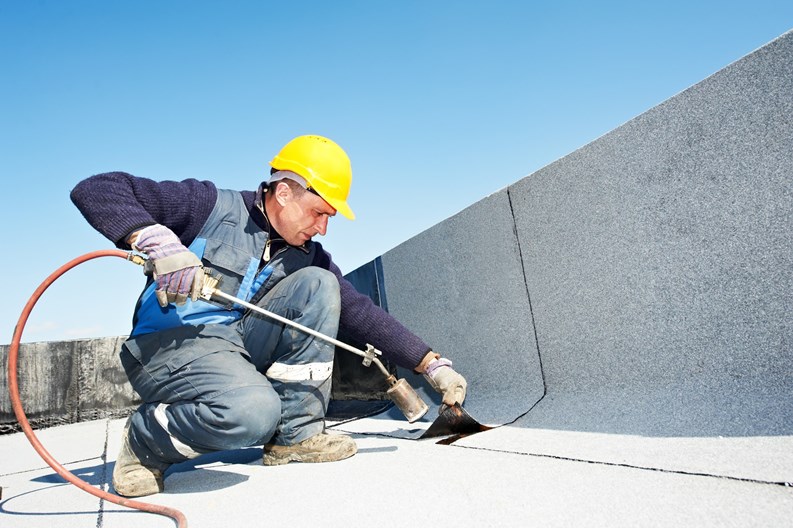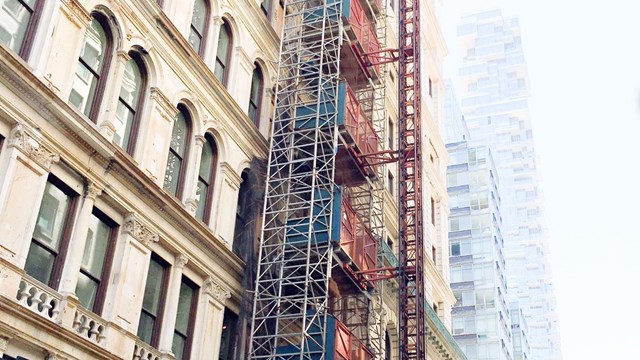With severe weather events becoming ever more common—and more intense—waterproofing your building’s envelope against rain, wind, snow, and ice is a growing concern. To counter the effects of climate change on buildings both old and new, our main focus must be on maintaining the integrity of the structural envelope. Proper, proactive exterior maintenance saves money on repairs, as well as operational costs like cooling, and heating—and a well-maintained building also provides better comfort for its residents.
What is the Building Envelope?
The building envelope or building enclosure is the physical separator between the conditioned and unconditioned environment of a building, including its resistance to air, water, heat, light, and noise transfer. A building’s envelope is all of the elements of the outer shell that maintain a dry, temperature-controlled indoor environment. The basic functions of the building envelope can be separated into three categories:
• Support – resistance and transference of structural and dynamic loads
• Control – regulating the flow of matter and energy of all types, including light, water, air, and environmental materials like dust, dirt, etc.
• Finish – expressing desired aesthetics on the inside and outside
The control function is at the core of good performance, and focuses, in order of importance, on rain control, air control, heat control, and vapor control.
According to Giulia Alimonti, vice president for building envelope in New York for Entuitive, an engineering firm with offices throughout North America, “The exterior envelope is the building’s physical barrier between indoor spaces and weather. A proper water- and airtight envelope is essential to protect health, comfort, and property. The envelope must be properly waterproofed to prevent water and moisture that could result in damage to the building from entering. You might otherwise get mold, which affects both the comfort and health of the building’s occupants. In addition, nowadays you can also get uncontrolled air infiltration, which can lead to pollution and smoke entering our homes with undesirable effects.”
“Waterproofing of roofs, windows, façades, and basements is an important aspect of building and residential health,” says Steve Morris, principal of Morris Engineering, located in Bedminster, New Jersey. “Unmitigated water infiltration will lead to structural damage, including rot to wood members or rusted and failed rebar in concrete portions of the building. Unmitigated water infiltration will also lead to damage to interior finishes like gypsum sheetrock and wood trim, which can then become food sources for mold. For people susceptible to mold, this can be a health concern.”
Roy Spencer, president of Perma-Seal Basement Systems located in Burr Ridge, Illinois, adds, “It’s critical that the building seal be effective, because water is the enemy of your home and building. It rots wood and concrete, brick and mortar. Also, because of the freezing/thawing cycle, when water gets in, the resulting ice expands to 10 times its liquid volume, which pushes against structural materials and creates more cracks. This can result in corrosion of steel structures and damage to interior finishes. If concrete is not waterproof, water will find its way to the rebar and can make the steel expand and push out the concrete, creating a cascading series of issues, even to the point of injury from falling bricks, or even building collapse.”
And there’s an even more insidious side to unaddressed leaks: mold. “Water deteriorates all structures as it penetrates and creates an environment for mold,” says Spencer, “and that’s just unhealthy. If water penetrates your home, it affects the health of both your home and you.”
An Ounce of Prevention
Building envelopes consist of masonry walls, windows, balconies, air conditioning sleeves, etc. Any point of discontinuity where two elements abut each other—of which there can be dozens, even hundreds in a large, complex structure—are potential points of entry for water and moisture to seep into the envelope. Windows and brick are notorious for this—but vigilance can help prevent infiltration, or at least catch and remedy it early if it does occur.
“Regular inspection and maintenance can keep an eye on new or existing cracks which can lead to infiltration of water or moisture into masonry,” says Alimonti. “All transition joints must be properly addressed with sealants, and the whole envelope must be properly and regularly inspected to prevent any gaps from weather, settlement of the building, or wind pressure. Microscopic movements can have a large effect, so periodically replacing sealant joints, repointing mortar, repairing or replacing window and door gaskets and weather stripping can ensure that they’re air- and watertight.”
According to Morris, “Damage to the flat roof surface, failed or missing shingles, failed or cracked vent boots, and improper ice dam protection can all lead to water infiltration. Roofs should have proper integrated flashing systems particularly, at penetrations, vents and curbs, valleys, drains or scuppers, and at eaves. Proper attic venting, eave flashing, and ice and water underlayment should be installed to prevent ice damming leaks.”
Spencer points out that different parts of the building should be tackled individually. “There’s above and below grade,” he says. “Two very different areas. In a basement and/or crawlspace, which is a big area of concern, it’s a natural thing for water to pool. We look at the structure and how it’s made. With poured concrete, our inspection is focused on looking for cracks. We have to secure that to prevent penetration. Additionally, when you dig a hole—as for a basement, for instance—you get hydrostatic pressure from underneath, so most basements have a drainage system that empties into a sump pump. That’s what relieves the water pressure from leaking up through the floor. It’s imperative to repair cracks and holes and to have a functioning drain tile and sump pump system.”
Basement water infiltration can also be caused by improperly sloped drainage adjacent to the building, ground water, and/or lack of a proper foundation waterproofing system or footing drain, explains Morris. Proper initial design and installation is the key to any water management system for a roof, cladding, or basement. “Maintenance can include some combination of replacement of failed sealants, replacement of coatings, crack repair, addressing window and door weather stripping and closures, roof patches, replacement of roof penetrations boots.”
The Assessment Process – Tech is Key
Alimonti describes the assessment process for building envelopes: “When we’re called for a leak, we go to the building and ask the property manager to run a survey of all tenants who might have a leak. Then we do a preliminary visual interior assessment. When that’s complete, we continue with an exterior assessment to find the point of entry for the water or moisture. We also do a localized spray water test and monitoring with an infrared camera to confirm the point of entry. We then complete selected masonry probes to see what’s happening inside the building envelope and fix it.”
“Technology is constantly improving tools to assist in evaluating and diagnosing the source of water infiltration,” says Morris. “One piece of technology that has been useful recently is the use of drones. Drones can assist in review and mapping of issues in hard to access sections of façades or roofs. This mapping can be forwarded to a contractor for repair. Once completed, the drone mission can be replicated to review for completion. In addition, regular missions can identify a perceived issue to document if it has increased over time. In addition, the drone can produce a ‘digital twin’ of the buildings so that façade and roof drawings can be generated. These façade and roof drawings are useful in mapping leak locations and cladding or roof issues.”
Spencer adds that “the newest thing in the industry is called the Basement Defender, which is a smart home component that can test sump pumps every day using WiFi. The sump pump is the most critical component in the protection system, and this new technology will report any problem with it. Sump pumps are used in any building with a basement—big apartment buildings included. They all need this.”
“We are using infrared cameras on drones that can identify discontinuity,” adds Alimonti, “to see where the thermal envelope is not acting as it should be, so we can see any anomalies. For roof checks, we put a metal wire into the roof assembly that detects leaks via electrical signals. Building materials are continuously improving as well. As material technology gets better, you want to use the new materials, which also last longer.”
In the end, it’s critically important to maintain your building envelope at optimal condition. Neglecting that maintenance may result in water finding its way inside the wall—and worse. “This is not to be trifled with,” says Alimonti. “Ignoring it makes it worse and more expensive. You don’t want your bricks popping out and killing someone.”
A J Sidransky is a staff writer/reporter for CooperatorNews and a published novelist. He may be reached at alan@yrinc.com.










Leave a Comment